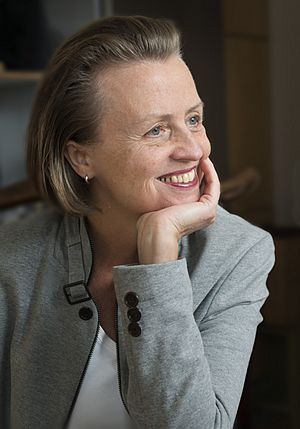Cecilie Ore facts for kids
Cecilie Ore (born July 19, 1954) is a famous composer from Norway. She is known for creating modern music that often explores interesting ideas about time and society.
Contents
Life and Music Career
Cecilie Ore was born in Oslo, Norway. She first studied piano at the Norwegian Academy of Music in Oslo and later in Paris. To learn more about composing, she studied at the Institute of Sonology in the Netherlands and with the composer Ton de Leeuw in Amsterdam.
Becoming Famous
In the 1980s, Ore became known around the world for her electro-acoustic music. This is a type of music that mixes the sounds of regular instruments with electronic sounds. In 1988, she won both first and second prize at a major competition called the International Rostrum for Composers for her piece Etapper. That same year, her orchestral work Porphyre was named "Work of the Year" by the Norwegian Society of Composers.
Exploring Time in Music
Towards the end of the 1980s, Ore became very interested in the idea of time. She created a series of musical pieces called Codex Temporis (which means "The Book of Time" in Latin). This series included works like Praesens Subitus for a string quartet and Futurum Exactum for 12 string instruments.
She continued to explore this theme in another series called Tempura Mutantur (meaning "Times Are Changed"). This group of works included pieces like Non Nunquam for a string trio and Ictus for six percussion players. Later, she wrote a trilogy of pieces named after different types of clouds: Cirrus, Cirrocumulus, and Cirrostratus.
Vocal and Opera Works
Ore has also written a lot of music for singers. In 1984, she composed Calliope for a female singer, which is still performed today. In 2001, her A – a shadow opera was performed for the first time at the Ultima Oslo Contemporary Music Festival.
After the year 2000, Ore began to focus more on music that commented on important social issues, like fairness and freedom of speech. In 2008, her chamber opera Dead Beat Escapement was performed at the Norwegian National Opera and Ballet. She also wrote an opera called Adam & Eve – a Divine Comedy, which premiered at the Bergen International Festival in 2015.
Honors and Awards
Cecilie Ore has received many awards for her music.
- First and second prize at the International Rostrum for Electro-Acoustic Music (1988)
- Work of the Year award from the Norwegian Society of Composers
- Norwegian State Guarantee Income for Artists (a special honor for talented artists)
- Arne Nordheim Composer's Prize (2004)
- Lindemanprisen (2015)
Selected Works
Ore writes both electro-acoustic music and music for traditional instruments and voices. Here are some of her well-known works:
- Etapper (1988)
- Calliope (1984) - for female voice
- Porphyre (1988) - for orchestra
- A – a shadow opera (2001)
- Cirrus (2002) - for string quartet
- Schwirren (2003) - for a vocal group
- Dead Beat Escapement (2008) - a chamber opera
- Come to the Edge! (2013)
- Adam & Eve – a Divine Comedy (2015) - an opera
- The Fig Leaf Campaign! (2017) - for a vocal group or choir


